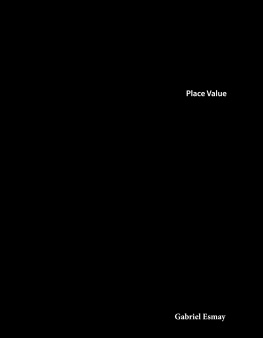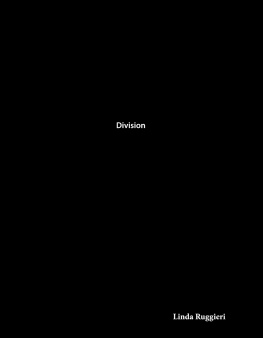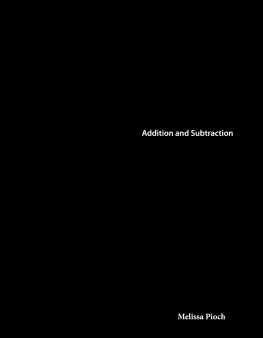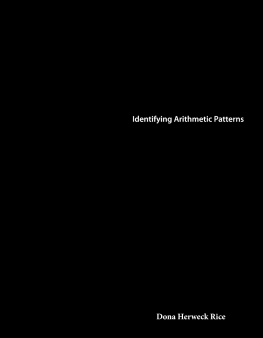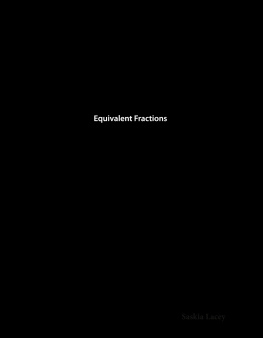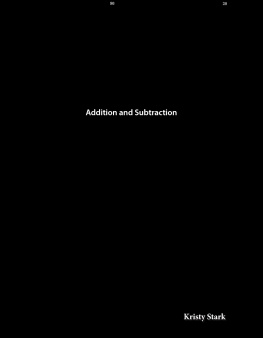Gabriel Esmay - The History of Number Systems: Place Value
Here you can read online Gabriel Esmay - The History of Number Systems: Place Value full text of the book (entire story) in english for free. Download pdf and epub, get meaning, cover and reviews about this ebook. year: 2017, publisher: Teacher Created Materials, genre: Politics. Description of the work, (preface) as well as reviews are available. Best literature library LitArk.com created for fans of good reading and offers a wide selection of genres:
Romance novel
Science fiction
Adventure
Detective
Science
History
Home and family
Prose
Art
Politics
Computer
Non-fiction
Religion
Business
Children
Humor
Choose a favorite category and find really read worthwhile books. Enjoy immersion in the world of imagination, feel the emotions of the characters or learn something new for yourself, make an fascinating discovery.
- Book:The History of Number Systems: Place Value
- Author:
- Publisher:Teacher Created Materials
- Genre:
- Year:2017
- Rating:3 / 5
- Favourites:Add to favourites
- Your mark:
- 60
- 1
- 2
- 3
- 4
- 5
The History of Number Systems: Place Value: summary, description and annotation
We offer to read an annotation, description, summary or preface (depends on what the author of the book "The History of Number Systems: Place Value" wrote himself). If you haven't found the necessary information about the book — write in the comments, we will try to find it.
The History of Number Systems: Place Value — read online for free the complete book (whole text) full work
Below is the text of the book, divided by pages. System saving the place of the last page read, allows you to conveniently read the book "The History of Number Systems: Place Value" online for free, without having to search again every time where you left off. Put a bookmark, and you can go to the page where you finished reading at any time.
Font size:
Interval:
Bookmark:
0page-covercover.xhtmlMath Talk 1. What is the difference between a rounded number andan exact number?2. What does a digits position in a number tell aboutits value?3. How is 10 used to organize the modern numbersystem?4. How can you use place value to compare twonumbers?5. One ancient number system never used any writing.Why do you think a written system is the one usedmost often now?6. What would a number system look like with no zeros?cover3page-page0003page0003.xhtml24page-page0004page0004.xhtmlTable of ContentsTimeless Need .......................................................4Egypt .....................................................................6Babylon................................................................10The Roman Empire .............................................14The Americas ......................................................16Modern Beginnings ............................................ 24Future of Number Systems ..................................27Problem Solving ..................................................28Glossary ..............................................................30Index ....................................................................31Answer Key .........................................................3235page-page0005page0005.xhtmlTimeless Need For as long as humans have walked the earth, they have needed to show numbers. Farmers count crops and animals. People track time. Merchants track goods. Builders measure structures. So, people of the past created number systems. Early cultures were very creative. People used pictures, letters, knots, dots, and bars. These symbols stood for numbers. They were carved in stone and clay. They were written on early forms of paper. They were even tied into string. These ancient number systems may not look the same as the modern number system. But keep looking. You may just see some things you recognize! geometry problems carved into a clay tablet from Babylon46page-page0006page0006.xhtmlEgyptian scribes count jugsduring the grape harvest.57page-page0007page0007.xhtmlEgyptThe Great Pyramid has stood in Egyptfor over four thousand years. It was madefrom more than two million large stoneblocks. It is the only wonder of theancient world that is still standing.Of course, no modern tools wereused. But the builders werenot alone. They had mathand number systemsto help. the Great Pyramid of GizaEgypt68page-page0008page0008.xhtmlEgyptian symbols donot look the same asnumerals today. Theywere glyphs, or pictures,that were carved intostone. They stood forwords and numbers.Just like today, 10 was a key number. Glyphs were carvedmany times to show larger numbers. To show the number 30,the glyph for 10 was carved three times. If 10 glyphs wereneeded, a different glyph was used. This way, thenumber did not take as long to carve.Egyptian glyphs79page-page0009page0009.xhtmlthe Rhind Papyrus810page-page0010page0010.xhtmlLater, Egyptians started writing on papyrus. It wasan early paper made out of plants. Over time, the lookof some glyphs changed. And, more glyphs were added.The system did not use place value. So, symbols could bewritten in any order. But still, Egyptians used the symbolsto do math. They could add and subtract. They could evenmultiply and divide.Egyptians could write math problems, too. They wrotethe Rhind Papyrus around 1550 BC. It was a very earlymath text. Many of the problems in the text are abouttriangles. Others ask how many loaves of bread can bebaked. Some ask how many bricks should be used to builda ramp. These problems helped Egyptians in their dailylives. But, there is one thing that was not found on itazero! Egyptians had no symbol for zero.911page-page0011page0011.xhtmlBabylonAround 2000 BC, a great city was emerging. Babylon wasknown for its size, beauty, power, and wealth. It is said to havehad stunning gardens perched high off the ground. But sofar, no one has found these gardens. What has been found isBabylons number system.The number system was based on groups of 60. Historyexperts have many thoughts about why they might havepicked 60. But no one knows for sure.The number symbols were wedge shaped, called cuneiform(kyoo-NEE-uh-form). They were carved in wet clay tabletswith a stylus. The wet clay was not easy to work with, and theycould not draw curved lines in any ofthe symbols. The wet clay was thendried in the sun. Many of thesetablets are still around.The ancient city of Babylon was southwestof modern-day Baghdad in Iraq.Iraq1012page-page0012page0012.xhtmlcuneiformHanging Gardens of Babylon1113page-page0013page0013.xhtmlBabylons number system used only two symbols. But,many numbers could still be formed. As in Egypt, symbolswere carved to write numbers, and there was still no symbolfor zero. But, there was one big difference between thesystems. The order of the symbols in Babylons systemmattered a lot.To keep track of the order, symbols were placed in columns.This told the value of the symbol. It was the first time placevalue had been used. This changed the way people viewednumbers. The modern number system is based on groupsof 10, not 60. But it still uses place value. We can thankBabylon for that!illustration of Babylon1214page-page0014page0014.xhtmlBabylonian number system1315page-page0015page0015.xhtmlThe RomanEmpireHave you ever seen clocks withletters instead of numbers? Or,have you ever noticed letters afterthe name of an event? Odds are, yousaw Roman numerals.The Roman Empire was known for its size and strength.Romans led the way in trade. They knew they needed away to keep track of their goods. So, they made a systemfor writing numbers around 850 BC. It would be the mainsystem of Europe for nearly two thousand years.The Romans used seven digits. The digits looked likeletters. And they were written from left to right. Dependingon the order, they would add or subtract the values of theletters.Roman numerals are sometimes still used today. But, thereis no symbol for zero. And there is no easy way to write largenumbers. So, other systems have been more widely used.Roman numeralson a clockfaceRoman Empire1416page-page0016page0016.xhtmlruins of the Roman Colosseum Pula Arena1517page-page0017page0017.xhtmlThe AmericasNot all number systems started in Europe, Africa, or Asia.Groups in the Americas had their own systems, too.The Maya EmpireThe Maya of North and Central America were a large group.Their culture peaked from AD 250 to AD 900. But people firstmoved to that area four thousand years ago.El Castillo pyramid in Mexico wasbuilt by the Maya around AD 1000.Maya Empire1618page-page0018page0018.xhtmlThe Maya were known for being an advanced people. Mathwas vital to them. Some of their art even shows people withnumber scrolls. The Maya built huge structures. They studiedthe skies and stars. They even built a wheel that kept track ofdays and years. They also bought, sold, and traded goods. So,they needed a number system. They had to be able to write anduse numbers in daily life.1719page-page0019page0019.xhtmlMaya number systemThe Maya number system was based on groupsof 20. Experts believe that the Maya may haveused 20 because it was as high as they couldcount on their fingers and toes. Whatever thereason, there were only three symbols in the Mayasystem. A dot stood for one. A bar stood forfive. And a symbol that looks like a shell stoodfor zero. This was a big deal! The Maya were thefirst to grasp the concept of zero. They also knewhow important it is for zero to have a symbol. Itmakes writing large numbers easier. Zero finallyhad a spot in the place value system! Whetheror not a zero is in the number, Maya numbersare read from the bottom up. The symbols arestacked on top of each other. Each level has acertain place value.1820page-page0020page0020.xhtmlTikal Temple INohoch Mul: 42 mEl Castillo: 30 mLa Danta: 70 mTikal Temple I: 47 mNohoch Mul1921page-page0021page0021.xhtmlThe Inca EmpireThe Inca Empire rose to power in South America aboutAD 1450. The empire was huge! It covered 300,000 squaremiles (780,000 square kilometers) of land. And, at its peak, itspopulation was around 12 million people.The Inca spoke 20 languages. But, they did not have a writtenlanguage. That meant they could not write numbers. But theystill had to find a way to keep track of numbers.Inca Empire Inca ruins in present-day Peru2022page-page0022page0022.xhtmlSo, the Inca tied knots on string. The group of knotted stringswas called a quipu (KEE-poo). This was a way to recordnumbers without writing. It could not help them solve mathproblems. But it was still very important to the Inca. In fact,there was a job called the keeper of the knots. People withthis job worked for the king.quipu2123page-page0023page0023.xhtmlThe quipu system was based on groups of 10. And,the concept of place value was used. Recording a largernumber meant tying more knots. The Inca did not have asymbol, or special knot, for zero. But, they did leave blankspaces where zeros would go.There were many things to track when using a quipu.First, the Inca had to know how to read the numbers fromthe knots. Second, only one number was shown on eachstring. A quipu could have many strings on it. So, theyhad to know what each number stood for. To help withthis, different-color strings were used. Colors had differentmeanings. Certain colors stood for the number of animals,such as cows or sheep. Some colors were symbols of war.Others were symbols of peace.A teacher gives a quipulesson to students.2224page-page0024page0024.xhtmlquipu2325page-page0025page0025.xhtmlModern BeginningsThe modern number system is made possible bynothing. Well, it is made possible by the concept andsymbol for nothingzero. It uses place value. Andzero can be used to show a place with no value.This system was formed in India around AD 650.But, it was the Arabs who first brought it to Europe.Before that, people counted on their fingers and toes.And they used letters as numbers.Indiapresent-day India2426page-page0026page0026.xhtmlThe Hindu-Arabic systemchanged all of this. It is based ongroups of 10. The digits rangefrom 0 to 9, like the digits usednow. But, they did not look thesame back then. The symbolswere more intricate. They tooklonger to write. Over time, theygot simpler to make writingfaster. They were easier to use inother ways, too. By using digitsand groups of 10, all numbers,small and large, can be writtenmore quickly. Soon, people sawhow helpful this system could be.This table shows the developmentof written numbers from the firstcentury to the fourteenth century.2527page-page0027page0027.xhtml2628page-page0028page0028.xhtmlFuture of Number SystemsAncient groups of people needed to express numbers. So,they made symbols that worked for them. We owe much to thepeople of the past. Place value, symbols, and zero paved theway for how we use numbers today. And number systems arestill changing.Computers use a number system that is based on groupsof 2, not 10. The binary system has just two digits: 0 and 1.Computers use it to store data and solve problems. So, no matterwhat a user types, computers change it all to 0s and 1s.Number systems have changed before. Will they changeagain? Many people now believe that we should use groupsof 12, not 10. But one thing is clear. However numbers arewritten or shown, we will always need them.2729page-page0029page0029.xhtmlProblem SolvingAt a site near Giza, Egypt, there are three hugepyramids named after kings Khafre, Khufu, andMenkaure. Along with the pyramids, there is a structure,the Great Sphinx, which has the body of a lion and thehead of a human.By now, some of the structures at Giza have lost a bit oftheir height due to erosion. Use the information in the tableto compare the heights of these famous structures as theystand today.1. Use or to compare the heights:a. Khufu Pyramid Khafre Pyramidb. Menkaure Pyramid Khafre Pyramidc. Menkaure Pyramid Great Sphinx2. Write the heights of the structures in orderfrom greatest to least.3. What is the height of each structure when roundedto the nearest ten?4. What is the height of each structure when roundedto the nearest hundred?5. Which set of rounded heights gives a more accurateestimate? Why do you think so?2830page-page0030page0030.xhtmlStructure HeightGreat Sphinx 66 ft.Khafre Pyramid 448 ft.Khufu Pyramid (Great Pyramid) 455 ft.Menkaure Pyramid 215 ft.2931page-page0031page0031.xhtmlGlossaryancientbelonging to a timelong agobinaryrelating to two partscropsplants grown byfarmerscuneiformwriting systemsthat have individual shapesmade from wedgesdigitswritten symbols forany numberserosionmovement ofweathered rock andsedimentglyphswritten charactersthat look like picturesintricatehaving manycomplex steps or partsnumber systemsmethodsfor expressing numberspapyrusa tall plant thatgrows in Egypt and can bemade into paperplace valuethe valueassigned to a digit based onits position in a numberquipuancient Incan methodof recording informationby tying knots indifferent-color threadsstylusa tool that was usedfor writing on clay tablets303032page-page0032page0032.xhtmlIndexBabylon, 1012binary system, 27Colosseum, 15Croatia, 15digits, 25, 27Egypt, 56, 12, 28Giza, 7, 28Great Sphinx, 2829Hindu-Arabic System, 25Inca, 2022India, 24Khafre Pyramid, 2829Khufu (Great) Pyramid, 6,2829Maya, 1619Menkaure Pyramid, 2829Pula Arena, 15Rhind Papyrus, 9Roman Empire, 1415zero, 9, 12, 14, 18, 22, 24, 273133page-page0033page0033.xhtmlAnswer KeyLets Explore Mathpage 7:Each height has 4 hundreds. But,5 tens is less than 8 tens. So, 455ft. must be less than 481 ft.page 9:1. Between 8 tens and 9 tens,or 80 and 902. 8 tens, or 80page 11:1. 600 BC2. 300 BCpage 15:1. The Colosseum held5 ten-thousands and PulaArena held 2 ten-thousands.So, the Colosseum heldmore people.2. The Colosseum held5 ten-thousands. PulaArena now holds only5 thousands.page 19:30 m, 42 m, 47 m, 70 mProblem Solving1. ab. c. 2. 455 ft.; 448 ft.; 215 ft.;66 ft.3. 70 ft.; 450 ft.; 460 ft.;220 ft.4. 100 ft.; 400 ft.; 500 ft.;200 ft.5. The set that has beenrounded to the nearest tenwould give a more accurateestimate. When roundedto the nearest hundred, theestimates are farther awayfrom the actual number.c3234page-page0034page0034.xhtml3335page-page0035page0035.xhtmlPlace ValueImagine doing your homework by carvingsymbols into stone, etching them intoclay, or tying knots into string. All ofthese things were done by ancientgroups of people who creatednumber systems and workedwith place value.Back Cover
Next pageFont size:
Interval:
Bookmark:
Similar books «The History of Number Systems: Place Value»
Look at similar books to The History of Number Systems: Place Value. We have selected literature similar in name and meaning in the hope of providing readers with more options to find new, interesting, not yet read works.
Discussion, reviews of the book The History of Number Systems: Place Value and just readers' own opinions. Leave your comments, write what you think about the work, its meaning or the main characters. Specify what exactly you liked and what you didn't like, and why you think so.

